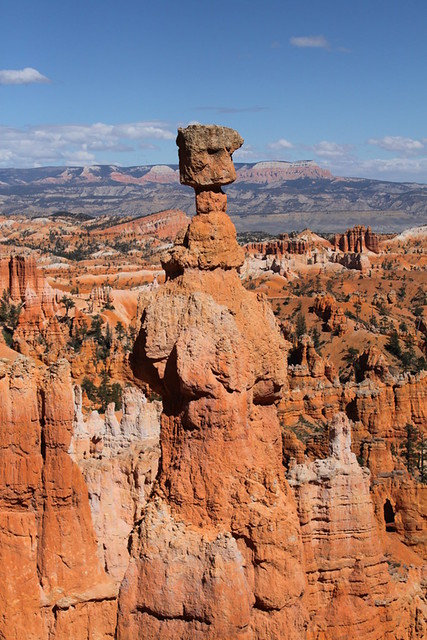
We were lucky enough to get to see some fabulous National Parks on our latest road-trippin’ holiday in the U.S. – lucky because two of the best closed with the government shutdown just a few days after we’d visited…
The one that knocked our socks off was Bryce Canyon. It’s a magical place where fairy folk and wicked queens most likely frolic; and where a painter with a fondness for red and an avant-garde sculptor must surely have been let loose a long time ago. (NB look out for the two tips at the end).
Bryce Canyon Mythology

The Paiute Indians who inhabited the area after earlier tribes like the Fremont and the Anasazi had moved on, found a way to explain the existence of the weirdly-shaped red rocks.
They believed that Legend People (To-when-an-ung-wa) used to inhabit the canyon. These people were animals, lizards and birds who looked human and were bad because they used up too much of the land’s resources. Because of this unacceptable behaviour, the mighty god Coyote lured the Legend People to what was supposed to be a celebration banquet, but instead turned them to rocks.
These would-be banqueters became the hoodoos that now make Bryce such a special place to be in, and the manner in which they’re clustered together near the rim reflects the panic that ensued when the Legend People realised what was happening to them. The red of the hoodoos is the war paint they were wearing at the time of their transformation.
The name the Paiute gave the area is a very suitable Agka-ku-wass-a-wits (red-painted faces). Or it may be
What’s a Hoodoo?

The word hoodoo, according to this post, was brought to America by black slaves who used it to refer to something approximating a jinx. It was picked up by Native Americans from fur trappers who were using it to refer to evil spirits or forces.
The formation that is a hoodoo is a totem-like column of soft stone that has survived only because it’s capped by a ‘hat’ of harder stone. It’s been shaped over millions of years by the vagaries of the weather.

Queen Victoria Hoodoo (www.geo.de)
As in all these places many of the limestone hoodoos of Bryce Canyon have been given names, including:
Queen Victoria
The Chessmen
Wall of Windows
Thor’s Hammer
Tower Bridge
The Poodle
The Sentinel
Queen’s Castle
The Hat Shop
Wall Street
Visitors and Settlers
Dutton and Powell
The Paiute were still living in the area when they first explorers and settlers arrived, including geologists and explorers Captain Clarence E. Dutton and John Wesley Powell. Some of the Paiute names for area features have stuck, apparently because of them:
Paunsaugunt: home of the beavers. (A plateau above Bryce.)
Paria: muddy water of elk water. (The river running through it.)
Panguitch, water or fish. (A nearby lake.)
Yovimpa: point of pines. (An area above the canyon – there’s an excellent view from Yovimpa point that many visitors miss – including us…)
Ebenezer Bryce

Serious People, the Bryces (dailykos.com)
One of the first Mormon settlers in the area and the man the canyon came to be named after was Scottish shipyard carpenter Ebenezer Bryce. He built a track to help transport the timber he was harvesting in the area and the visitors who used it began to call the canyon at the end of the track Bryce’s Canyon.
It may be apocryphal, but Ebenezer is said to have told an admirer of the hoodoos, “It’s a hell of a place to lose a cow”. Even though he and his family moved away from the area to Arizona, his name will always be associated with the place.
The Canyon isn’t his only claim to fame – he designed the oldest Mormon chapel still in continuous use, Pine Valley Chapel, even though he had never designed one before. He did it on the condition that he was allowed to build it like a ship.
3 Tips for Visiting the Canyon
An excellent hike is the Navajo Loop combined with the Queens Garden Trail. It took us about 1.5 hours and we’re not spectacularly fit (to put it mildly). BUT start at Sunset Point and end at Sunrise point – not the other way around. The slope up to Sunset Point is fierce. Early morning is better as it gets quite crowded near the points, and not everyone seems to agree with me that it’s nice to appreciate magnificent areas like this quietly. Plus the light’s better at this time of day.
If you’re attending the ranger’s astronomy evening, check beforehand how many telescopes are likely to be used that night. Although we had expected eight, there were only two on the night. The queues for them were enormous.
Ruby’s Inn Best Western has microwaves in each of its rooms and there’s a very decent supermarket on site if you have had enough enormous on-the-road meals to last a lifetime.
Top 3 Photos: Strange and Weird Bryce Canyon – Photo by Quirky Travel

Born in Belfast and now living in London, Julie McNamee is involved in internet marketing as a day job and blogging as a hobby. She’s interested in all things quirky and Fortean, as well as art, photography and theatre. Her blog Quirky Travel, specializes in London and Paris top tips and off the beaten path information with subjects such as London film locations and unusual Paris museums.








